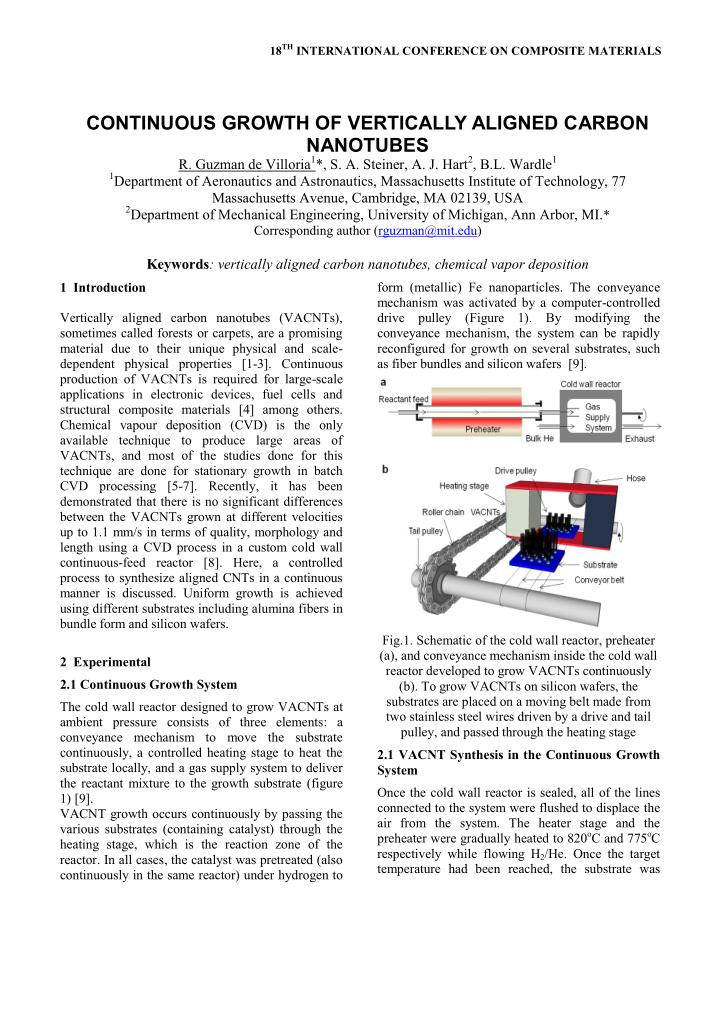



18 TH INTERNATIONAL CONFERENCE ON COMPOSITE MATERIALS CONTINUOUS GROWTH OF VERTICALLY ALIGNED CARBON NANOTUBES R. Guzman de Villoria 1 *, S. A. Steiner, A. J. Hart 2 , B.L. Wardle 1 1 Department of Aeronautics and Astronautics, Massachusetts Institute of Technology, 77 Massachusetts Avenue, Cambridge, MA 02139, USA 2 Department of Mechanical Engineering, University of Michigan, Ann Arbor, MI. * Corresponding author (rguzman@mit.edu) Keywords : vertically aligned carbon nanotubes, chemical vapor deposition 1 Introduction form (metallic) Fe nanoparticles. The conveyance mechanism was activated by a computer-controlled Vertically aligned carbon nanotubes (VACNTs), drive pulley (Figure 1). By modifying the sometimes called forests or carpets, are a promising conveyance mechanism, the system can be rapidly material due to their unique physical and scale- reconfigured for growth on several substrates, such dependent physical properties [1-3]. Continuous as fiber bundles and silicon wafers [9]. production of VACNTs is required for large-scale applications in electronic devices, fuel cells and structural composite materials [4] among others. Chemical vapour deposition (CVD) is the only available technique to produce large areas of VACNTs, and most of the studies done for this technique are done for stationary growth in batch CVD processing [5-7]. Recently, it has been demonstrated that there is no significant differences between the VACNTs grown at different velocities up to 1.1 mm/s in terms of quality, morphology and length using a CVD process in a custom cold wall continuous-feed reactor [8]. Here, a controlled process to synthesize aligned CNTs in a continuous manner is discussed. Uniform growth is achieved using different substrates including alumina fibers in bundle form and silicon wafers. Fig.1. Schematic of the cold wall reactor, preheater (a), and conveyance mechanism inside the cold wall 2 Experimental reactor developed to grow VACNTs continuously 2.1 Continuous Growth System (b). To grow VACNTs on silicon wafers, the substrates are placed on a moving belt made from The cold wall reactor designed to grow VACNTs at two stainless steel wires driven by a drive and tail ambient pressure consists of three elements: a pulley, and passed through the heating stage conveyance mechanism to move the substrate continuously, a controlled heating stage to heat the 2.1 VACNT Synthesis in the Continuous Growth substrate locally, and a gas supply system to deliver System the reactant mixture to the growth substrate (figure Once the cold wall reactor is sealed, all of the lines 1) [9]. connected to the system were flushed to displace the VACNT growth occurs continuously by passing the air from the system. The heater stage and the various substrates (containing catalyst) through the preheater were gradually heated to 820 o C and 775 o C heating stage, which is the reaction zone of the respectively while flowing H 2 /He. Once the target reactor. In all cases, the catalyst was pretreated (also temperature had been reached, the substrate was continuously in the same reactor) under hydrogen to
Recommend
More recommend